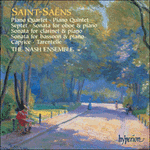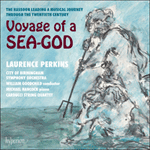With the world still reeling from the devastating effects of the Great War, it’s a sobering observation that the League of Nations was established in the same year (1921) Adolf Hitler became leader of the Nazi Party in Germany. The creative activities of that time underline the stark contrasts between looking back and forging ahead. The future was perceived to be with such groups as the Paris-based Surrealism movement and with the musical output of Les Six, much of which was despised by the composer once described by his colleague Charles Gounod as the ‘French Beethoven’.
The final works by Saint-Saëns—the Bassoon Sonata in G major, Op 168, and the Feuillet d’album for piano, Op 169—are stylistically firmly rooted in the nineteenth century. This is hardly surprising—he was born in 1835, quickly emerging as a musical prodigy, starting piano lessons aged two, and giving his first official public concert aged ten. It was eight decades later that he turned to the bassoon for some of his final musical inspirations. The sonata’s dedication was ‘à Monsieur Léon Letellier, Premier Basson de l’Opéra et de la Société des Concerts’. Given the musical and technical challenges of this sonata, Saint-Saëns really needed a player of the calibre of Letellier, who won the first prize for bassoon in the concours at the Paris Conservatoire in 1879. After a lyrical and highly expressive first movement, the bassoonist is plunged into a seriously challenging scherzo, where the superb Mozartian clarity of Saint-Saëns’s writing makes the music even more demanding—not least with a notorious low-dynamic ascent to the bassoon’s elusive top E at the end of the movement. The gentle mood of the third movement—slow, but with a brief, joyous concluding section—provides a welcome contrast. It features a beautifully crafted, often very sparse piano part which allows to the bassoon the fullest range of dynamics and colour.
from notes by Laurence Perkins © 2021
Les sonates furent les contributions les plus pérennes de Saint-Saëns à la littérature de chambre: il en composa deux pour violon et piano, deux pour violoncelle et piano, une pour hautbois, une pour clarinette et une pour basson – toutes trois avec accompagnement de piano. Ce fut dans la dernière année de sa vie qu’il conçut l’idée d’écrire une sonate pour chacun des instruments à vent en bois, ce qui étoffa leur répertoire et offrit à la littérature de la sonate trois monuments. La
Sonate pour hautbois en ré majeur, op. 166, dédiée à l’extraordinaire hautboïste virtuose Louis Bas, fut suivie de la
Sonate pour clarinette en mi bémol majeur, op. 167, dédiée à Auguste Perier (bon interprète, à la technique époustouflante), puis de la
Sonate pour basson en sol majeur, op. 168, écrite pour Léon Letellier, premier basson de l’Opéra et de la Société des Concerts. Saint-Saëns avait aussi l’intention de composer des sonates pour flûte et pour cor anglais, mais la mort l’en empêcha. Dans chaque sonate, le piano est habilement intégré à l’instrument à vent, dont le timbre et la polyvalence sont montrés de manière experte. Les lignes classiques parcimonieuses, évocatrices, et les mélodies lancinantes, doublées de superbes structures formelles, rehaussent ces phares du mouvement néo-classique. Saint-Saëns ne vit jamais ces œuvres jouées de son vivant, mais il eut quand même la satisfaction d’apprendre qu’elles plurent à leurs dédicataires. On ne dira jamais assez leur importance dans le répertoire des bois.
extrait des notes rédigées par Sabina Teller Ratner © 2005
Français: Hypérion
Die langlebigsten Kammermusikwerke von Saint-Saëns sind seine Sonaten: er komponierte zwei für Violine und Klavier, zwei für Cello und Klavier und jeweils eine für Oboe, Klarinette und Fagott, jeweils mit Klavierbegleitung. Saint-Saëns hatte in seinem letzten Lebensjahr die Idee entwickelt, eine Sonate für jedes Holzblasinstrument zu schreiben, was das Repertoire für die drei Instrumente erweiterte und die Sonatenliteratur um drei monumentale Werke reicher machte. Als erstes komponierte er die
Oboensonate in D-Dur op. 166, die er dem großen Oboenvirtuosen Louis Bas widmete, darauf die
Klarinettensonate in Es-Dur op. 167, dem renommierten Klarinettisten Auguste Perier gewidmet, und schließlich die
Fagottsonate in G-Dur op. 168 für Léon Letellier, der an der Opéra und in der Société des Concerts erstes Fagott spielte. Außerdem hatte Saint-Saëns eine Flötensonate und eine Sonate für Englischhorn geplant, doch starb er, bevor er seinen Sonatenzyklus abschließen konnte. In allen drei Sonaten ist die Klavierstimme auf kunstvolle Art mit dem Bläserpart verbunden. Das jeweilige Timbre und die Vielseitigkeit der drei Instrumente kommen in meisterhafter Weise zum Ausdruck. Die schlichten, sinnträchtigen, klassischen Melodien, schwermütigen Weisen und die hervorragenden formalen Strukturen untermauern diese Leitsterne der neoklassischen Bewegung. Obwohl die Werke nicht mehr zu seinen Lebzeiten aufgeführt wurden, so wusste Saint-Saëns doch wenigstens, dass ihre Widmungsträger sie schätzten. Ihre Bedeutung für das Holzbläser-Repertoire kann gar nicht hoch genug angesiedelt werden.
aus dem Begleittext von Sabina Teller Ratner © 2005
Deutsch: Viola Scheffel


 Saint-Saëns: Chamber Music
Saint-Saëns: Chamber Music Voyage of a sea-god
Voyage of a sea-god
